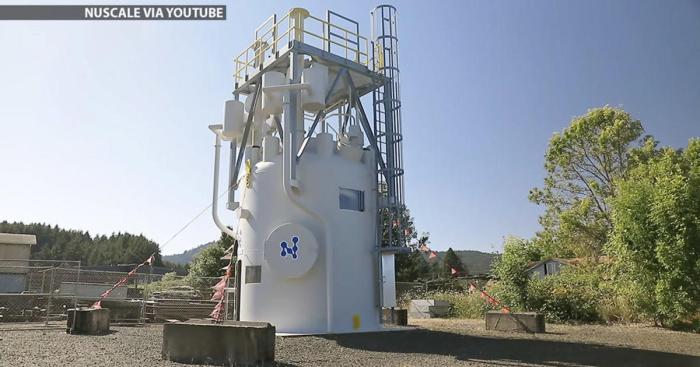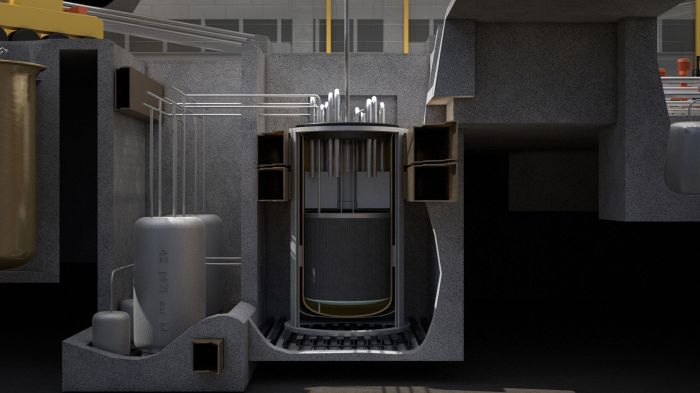Small modular nuclear reactors (SMRs) are emerging as a promising solution to the world’s energy challenges. These innovative reactors offer a range of benefits, including reduced costs, increased safety, and enhanced flexibility.
SMRs are designed to be smaller and more affordable than traditional nuclear reactors, making them more accessible to a wider range of communities. They also incorporate advanced safety features, such as passive cooling systems, which reduce the risk of accidents.
Introduction
Small Modular Nuclear Reactors (SMRs) are advanced nuclear reactors that generate electricity on a smaller scale compared to traditional nuclear power plants. They are designed to be more flexible, cost-effective, and safer than larger reactors.
The concept of SMRs is based on the idea of modularity, where multiple small reactors can be combined to meet the specific energy needs of a community or industry. This modular approach allows for greater flexibility in siting and deployment, as well as the ability to scale up or down electricity production as needed.
Purpose of SMRs
SMRs are primarily intended to address the growing demand for clean and reliable energy while addressing concerns about climate change and energy security. They offer several advantages over traditional nuclear power plants, including:
- Reduced Capital Costs:SMRs are designed to be more cost-effective to build and operate than larger reactors due to their smaller size and simplified design.
- Increased Safety:SMRs incorporate advanced safety features, such as passive cooling systems and inherent stability, which minimize the risk of accidents and enhance overall safety.
- Flexibility and Scalability:The modular nature of SMRs allows for greater flexibility in siting and deployment, as well as the ability to scale up or down electricity production as needed.
- Reduced Environmental Impact:SMRs produce minimal greenhouse gas emissions and do not require large amounts of fuel, reducing their environmental footprint.
Benefits of SMRs: Small Modular Nuclear Reactors
Small modular reactors (SMRs) offer numerous potential benefits, including:
- Reduced construction time and costs:SMRs are designed to be built in a factory setting, which can significantly reduce construction time and costs compared to traditional nuclear power plants.
- Increased safety:SMRs incorporate advanced safety features, such as passive cooling systems and containment structures, which enhance their safety and reduce the risk of accidents.
- Flexibility:SMRs can be deployed in a variety of locations, including remote areas or urban centers, and can be scaled to meet the specific energy needs of a community.
- Reduced carbon emissions:SMRs generate electricity without producing greenhouse gases, making them a clean and sustainable energy source.
Addressing Energy Challenges
SMRs can play a significant role in addressing global energy challenges, such as:
- Meeting growing energy demand:SMRs can provide a reliable and affordable source of energy to meet the increasing demand for electricity worldwide.
- Reducing carbon emissions:By replacing fossil fuel-based energy sources, SMRs can contribute to reducing greenhouse gas emissions and mitigating climate change.
- Improving energy security:SMRs can enhance energy security by diversifying energy sources and reducing dependence on foreign energy imports.
Challenges of SMRs
Despite their potential benefits, SMRs also face several challenges that need to be addressed for their successful development and deployment.
One of the major challenges is the high upfront investment costs associated with SMRs. The construction and installation of an SMR can be significantly more expensive than traditional large-scale nuclear reactors, which can hinder their economic viability.
Regulatory Uncertainties
SMRs are a relatively new technology, and there are still uncertainties regarding their regulatory framework. Establishing clear and consistent regulations for SMRs is crucial to ensure their safe and efficient deployment. This includes addressing issues related to licensing, siting, and safety standards.
Applications of SMRs

Small modular reactors (SMRs) offer a versatile and scalable solution for a wide range of energy needs across various industries and sectors.
SMRs can be tailored to meet specific requirements, making them suitable for applications such as:
Electricity Generation
- SMRs can provide reliable and cost-effective electricity for remote communities, islands, and industrial facilities.
- They can also complement intermittent renewable energy sources, ensuring a stable and resilient power supply.
Industrial Processes
- SMRs can generate high-temperature steam for industrial processes such as enhanced oil recovery, hydrogen production, and desalination.
- They can also provide reliable heat for manufacturing and mining operations.
Transportation
- SMRs can be used to power electric vehicles, ships, and aircraft, reducing carbon emissions and dependence on fossil fuels.
- They can also provide electricity for charging stations and transportation hubs.
District Heating
- SMRs can generate heat for district heating systems, providing efficient and environmentally friendly space heating and hot water for homes and businesses.
- They can also be used to produce cooling during summer months.
Medical and Research
- SMRs can produce isotopes for medical applications, such as cancer treatment and diagnostic imaging.
- They can also be used for research in nuclear physics and materials science.
Safety and Security of SMRs

Small modular reactors (SMRs) prioritize safety and security as fundamental principles in their design and operation. These reactors incorporate advanced safety features to minimize the risk of accidents and mitigate their potential consequences.
Safety Features of SMRs
SMRs employ multiple layers of defense to enhance safety. These include:
Passive Safety Systems
These systems rely on natural forces, such as gravity and convection, to cool the reactor and prevent overheating. They operate independently of external power sources, ensuring continued operation even in the event of a power outage.
Containment Structures
SMRs are housed within robust containment structures designed to withstand extreme conditions and prevent the release of radioactive material into the environment.
Advanced Fuel Designs
SMRs utilize advanced fuel designs that are more resistant to damage and can withstand higher temperatures than traditional fuel rods.
Digital Control Systems
These systems provide real-time monitoring and control of the reactor, allowing operators to respond quickly to any potential issues.
Security Measures for SMRs
In addition to safety features, SMRs are also designed with robust security measures to protect against potential threats. These measures include:
Physical Security
SMRs are located in secure facilities with controlled access and surveillance systems.
Cybersecurity
SMRs employ advanced cybersecurity measures to protect against unauthorized access and cyberattacks.
Emergency Response Plans
Comprehensive emergency response plans are in place to address potential security incidents and ensure the safety of the public and the environment.
Regulations and Standards for SMRs
The regulatory framework for SMRs is still under development in many countries. However, there are a number of international organizations that are working to develop harmonized standards for SMRs. These organizations include the International Atomic Energy Agency (IAEA), the World Nuclear Association (WNA), and the Nuclear Energy Agency (NEA).
The IAEA has developed a number of safety standards for SMRs, including the “Safety of Small and Medium Sized Reactors” (SSMR) series of standards. These standards cover a wide range of topics, including design, construction, operation, and decommissioning of SMRs.
The WNA has developed a number of technical reports on SMRs, including the “SMR Technology Roadmap” and the “SMR Deployment Guide.” These reports provide guidance on the design, construction, and operation of SMRs.
The NEA has developed a number of safety assessment reports on SMRs, including the “Assessment of the Safety of Small and Medium Sized Reactors” (ASM-SMR) report. This report provides a comprehensive assessment of the safety of SMRs.
Role of Standards in Ensuring the Safety and Reliability of SMRs, Small modular nuclear reactors
Standards play a vital role in ensuring the safety and reliability of SMRs. By providing a common set of requirements for the design, construction, and operation of SMRs, standards help to ensure that these reactors are built and operated in a safe and reliable manner.
Standards also help to facilitate the regulatory process for SMRs. By providing a clear set of requirements that SMRs must meet, standards help to streamline the regulatory process and make it more efficient.
In addition, standards help to promote the international deployment of SMRs. By providing a common set of requirements for SMRs, standards help to ensure that these reactors can be safely and reliably deployed in a variety of countries.
Future of SMRs
SMRs are anticipated to play a significant role in the future of energy production. With their inherent advantages, they hold the potential to transform the energy landscape and address pressing challenges related to climate change and energy security.
Ongoing research and development efforts are focused on enhancing SMR technology, exploring innovative designs, and improving efficiency. Advancements in materials science, manufacturing techniques, and digital technologies are expected to lead to the development of even smaller, more efficient, and cost-effective SMRs.
Potential Future Developments
- Advanced Fuel Technologies:Research is underway to develop advanced fuel technologies that can enhance the performance and safety of SMRs. These include accident-tolerant fuels, which are more resistant to damage during extreme events, and fuels with higher energy density, allowing for longer operating cycles.
- Integrated Energy Systems:SMRs are being explored for integration with other renewable energy sources, such as solar and wind power. This integration can help balance intermittent renewable energy sources and provide a reliable and flexible energy supply.
- Small Modular Reactors for Remote Areas:SMRs are particularly well-suited for remote areas that lack access to reliable electricity. They can provide a clean and sustainable energy source for communities and industries in these regions.
Expected Impact on the Energy Landscape
- Decarbonization:SMRs are expected to contribute significantly to decarbonization efforts by providing a low-carbon source of electricity. They can help reduce reliance on fossil fuels and mitigate climate change.
- Energy Security:SMRs can enhance energy security by diversifying energy sources and reducing dependence on imported fuels. They can also provide a reliable backup power source during emergencies.
- Economic Development:The deployment of SMRs can create new jobs and stimulate economic growth. They can also support the development of local supply chains and industries related to nuclear energy.
Concluding Remarks

As the world transitions to a clean energy future, SMRs are poised to play a significant role. Their ability to provide reliable, affordable, and emissions-free electricity makes them an attractive option for governments and utilities around the globe.
Questions Often Asked
What are the main benefits of SMRs?
SMRs offer a range of benefits, including reduced costs, increased safety, enhanced flexibility, and reduced environmental impact.
How do SMRs compare to traditional nuclear reactors?
SMRs are smaller, more affordable, and more flexible than traditional nuclear reactors. They also incorporate advanced safety features.
What are the potential challenges associated with SMRs?
Potential challenges associated with SMRs include public acceptance, regulatory hurdles, and waste management.